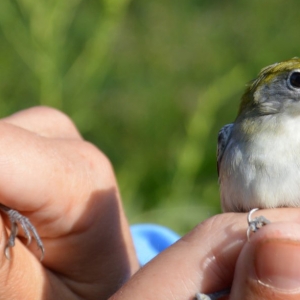Bird banding activities began at Rushton Woods Preserve in late fall of 2009 with funds donated by the Delaware Valley Ornithological Club.
Since that time, thousands of birds have been documented by our banding team, revealing a vibrant, thriving population of birds that use our open spaces as an important stopover during migration or as a permanent home for their breeding and nesting sites.
Located within an 86-acre nature preserve and adjacent to Rushton Farm, the banding station is uniquely sited to measure bird populations' response to agroecological farming practices and habitat restoration and management.
Join Us for Bird Banding at Rushton Woods Preserve!
Thousands of visitors, school students, college students, and grad students visit or conduct research at the Rushton Woods Preserve banding station annually. Its unique site within an 86-acre nature preserve and adjacent to the sustainable farming operation at Rushton Farm offers a remarkable opportunity to measure birds' response to our land protection, habitat restoration, and sustainable farming activities.
Teaching children and adults the value of conservation, the importance of preserving open space, and the value and use of scientific research skills are the passions that we strive to share with all of the participants who visit our bird banding station.
You are invited to visit the Trust's bird banding station where you can observe all phases of bird banding research including:
- setting up and taking down mist-nets
- taking birds from nets
- identifying, aging, and sexing each bird
- weighing and measuring birds
- documenting research into the federal data bank
- documenting with photography
Coordinated by Lisa Kiziuk and led by Doris McGovern, both federally and state licensed bird banders, our staff invite you to visit the station during the season to observe our avian research program.
Park in the Rushton Woods Preserve parking lot, located at the southeast corner of Goshen and Delchester Roads, with the entrance on Delchester Road. Walk towards the hedgerows opposite the parking lot and follow the path to the right which eventually turns left and cuts through the hedgerow. Take the left path and follow until you see our banding station.
Our banding program runs during spring migration (April - May) and fall migration (September - November) as weather permits - we don't band if it rains or if temperatures fall below 40 degrees. Please visit our Events page to sign up for our upcoming bird banding events.
In October, after neo-tropical migrants have left our region, we begin Northern Saw-whet Owl research, capturing migrating Saw-whet Owls in the evenings. Owl Banding is closed to the public.
If you are interested in participating in bird banding, email Lisa Kiziuk at lkr@wctrust.org.
Why Band Birds in Willistown?
Bird banding provides valuable information for the study of dispersal, migration, survival rate, reproductive success, and population growth. At Rushton Woods Preserve, we band to document the seasonal and long term population patterns of migratory and resident species. Banding allows us to track individuals, which is important in determining survival, migratory stopover rates, and longevity.
Additionally, banding birds allows us to examine bird population response to the various initiatives undertaken by the Trust, many of which impact bird habitat. These initiatives include further protection of land from development; creation of native wildflower meadows and grasslands; sustainable farming; streamside tree planting and riparian restoration; promotion of the use of native plants; promotion of reduced mowing; and reduction of the local deer herd via our deer management program.
As more and more habitat in the Willistown area is protected and restored with native plants, bird populations in our area will rise correspondingly. The data we contribute through banding is important for homeowners, land managers, and those designing future projects to create habitats supporting healthy, vibrant bird populations.
Ten Years of Songbird Research at Rushton Woods Preserve | 2010-2019
In May 2009, Willistown Conservation Trust received a Conservation Grant from the Delaware Valley Ornithological Club (DVOC) and opened the Rushton Woods Preserve Bird Banding Station. Limited banding effort in 2009 ignited a successful bird conservation program connecting science and education through our bird banding station.
Located in the shrub-scrub hedgerows at Rushton Woods Farm and Preserve, we have been studying how migratory birds’ abundance and diversity is impacted by preserved land with sustainable agriculture practices in close proximity. Banding operations take place in the shrub-scrub hedgerows during each migratory season. Starting with ten fixed net locations in 2010, we have expanded to running sixteen nets in 2019. Among lessons learned are the abundance and diversity of songbirds that use the preserve during migration as well as the impact of the quality of habitat available at Rushton.
What started as spring and fall migratory songbird banding in 2009 has since grown to include a breeding bird banding program during the summer season. Referred to as MAPS (Monitoring Avian Productivity and Survivorship), we follow a national protocol for our breeding bird banding station, which is managed by the Institute for Bird Populations (www.birdpop.org). Our breeding banding program is operated within Rushton Woods Preserve where ten fixed net locations have remained consistent since 2011.
Read the full report and research accomplished by Alison Fetterman, Bird Conservation Associate and Pennsylvania Motus Project Manager here.
Bird Banding Contributes to Global Conservation Efforts
The bird banding station at Rushton Woods Preserve, along with all banding facilities in North America, reports banding data to the Bird Banding Laboratory of the United States Geologic Service, which stores this information. This enormous data bank is available worldwide to researchers and scientists studying migration and population dynamics, breeding site fidelity, and reproductive success.
If you find a dead bird with a band on it, use https://www.pwrc.usgs.gov/BBL/bblretrv/ or call the Bird Banding Lab at 1-800-327-2263 with the band number and information about when and where the bird or band was found. This will provide important information to both those who originally banded the bird and the bird community.


